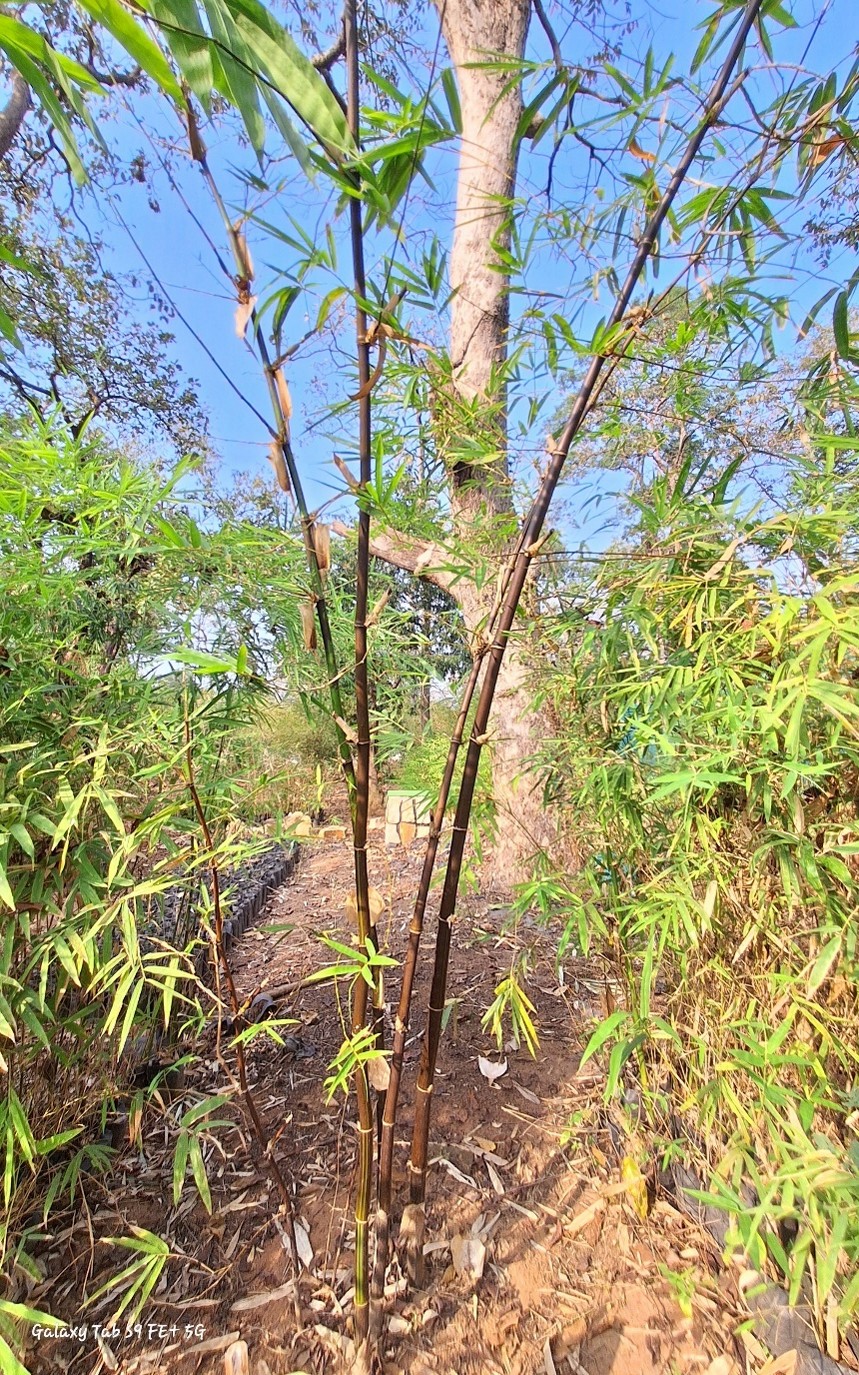Bambusa vulgaris var. black,

Bambusa vulgaris var. black,
Bambusa vulgaris var. black,also known as Black Bamboo, Black-stemmed Bamboo, or Dark Bamboo, is a striking variety of Bambusa vulgaris. This bamboo variety is characterized by its clumping, erect habit and distinctive black culms, which provide a dramatic contrast with its green foliage. The culms are initially green but gradually turn deep black or dark purple as they mature. It typically grows to a height of 8 to 12 meters, with a diameter ranging from 6 to 10 cm. The internode length ranges from 25 to 40 cm, and the culm sheath is green when young, turning dark brown or blackish as it matures. The adaxial surface of the culm sheath is smooth and glabrous, while the abaxial surface is hairy at first but becomes smooth over time. The margin of the sheath is ciliate. The leaves of Bambusa vulgaris var. black are narrow-lanceolate with pointed tips, measuring 15 to 30 cm in length and 2 to 4 cm in breadth. This variety thrives at altitudes between 100 and 1,200 meters and prefers well-drained, loamy soils but is adaptable to a variety of soil types, including sandy and clayey soils. It requires a moderate to high level of rainfall, with an annual rainfall range of 1,200 to 3,000 mm, thriving in tropical and subtropical climates with consistent moisture.
Native to tropical and subtropical regions of Southeast Asia and parts of India, Bambusa vulgaris var. black is widely cultivated around the world, particularly in regions with warm climates like Europe, Africa, and the Americas, primarily for ornamental and landscaping purposes. It is commonly found in gardens, parks, and private landscapes, where its striking black culms make it a focal point. The inflorescence is a small panicle with bracteate heads and spicate branching, with ovate, acute empty glumes that have several nerves, and flowering glumes that are larger with ciliate margins. The stamens are exserted with glabrous anthers, and the style is covered with fine hairs. Flowering is a rare event, occurring once every 30 to 50 years, and has been recorded in tropical regions. Seed production is uncommon, and propagation is mainly achieved through vegetative methods such as clump division, culm cuttings, offsets, and tissue culture.
Bambusa vulgaris var. black is highly prized for its ornamental value, often used in landscaping as a decorative element or privacy screen. It is used in light construction, such as making poles, fencing, and other structures. Additionally, the bamboo is ideal for crafting bamboo furniture, baskets, and decorative items. The shoots of this bamboo are edible and are commonly used in culinary dishes in Asia. It is also utilized in pulp and paper production, and its dense growth makes it an effective choice for privacy screens and natural hedges.
also known as Black Bamboo, Black-stemmed Bamboo, or Dark Bamboo, is a striking variety of Bambusa vulgaris. This bamboo variety is characterized by its clumping, erect habit and distinctive black culms, which provide a dramatic contrast with its green foliage. The culms are initially green but gradually turn deep black or dark purple as they mature. It typically grows to a height of 8 to 12 meters, with a diameter ranging from 6 to 10 cm. The internode length ranges from 25 to 40 cm, and the culm sheath is green when young, turning dark brown or blackish as it matures. The adaxial surface of the culm sheath is smooth and glabrous, while the abaxial surface is hairy at first but becomes smooth over time. The margin of the sheath is ciliate. The leaves of Bambusa vulgaris var. black are narrow-lanceolate with pointed tips, measuring 15 to 30 cm in length and 2 to 4 cm in breadth. This variety thrives at altitudes between 100 and 1,200 meters and prefers well-drained, loamy soils but is adaptable to a variety of soil types, including sandy and clayey soils. It requires a moderate to high level of rainfall, with an annual rainfall range of 1,200 to 3,000 mm, thriving in tropical and subtropical climates with consistent moisture.
Native to tropical and subtropical regions of Southeast Asia and parts of India, Bambusa vulgaris var. black is widely cultivated around the world, particularly in regions with warm climates like Europe, Africa, and the Americas, primarily for ornamental and landscaping purposes. It is commonly found in gardens, parks, and private landscapes, where its striking black culms make it a focal point. The inflorescence is a small panicle with bracteate heads and spicate branching, with ovate, acute empty glumes that have several nerves, and flowering glumes that are larger with ciliate margins. The stamens are exserted with glabrous anthers, and the style is covered with fine hairs. Flowering is a rare event, occurring once every 30 to 50 years, and has been recorded in tropical regions. Seed production is uncommon, and propagation is mainly achieved through vegetative methods such as clump division, culm cuttings, offsets, and tissue culture.
Bambusa vulgaris var. black is highly prized for its ornamental value, often used in landscaping as a decorative element or privacy screen. It is used in light construction, such as making poles, fencing, and other structures. Additionally, the bamboo is ideal for crafting bamboo furniture, baskets, and decorative items. The shoots of this bamboo are edible and are commonly used in culinary dishes in Asia. It is also utilized in pulp and paper production, and its dense growth makes it an effective choice for privacy screens and natural hedges.
Listen Audio:
Need assistance? BRTC Faculty